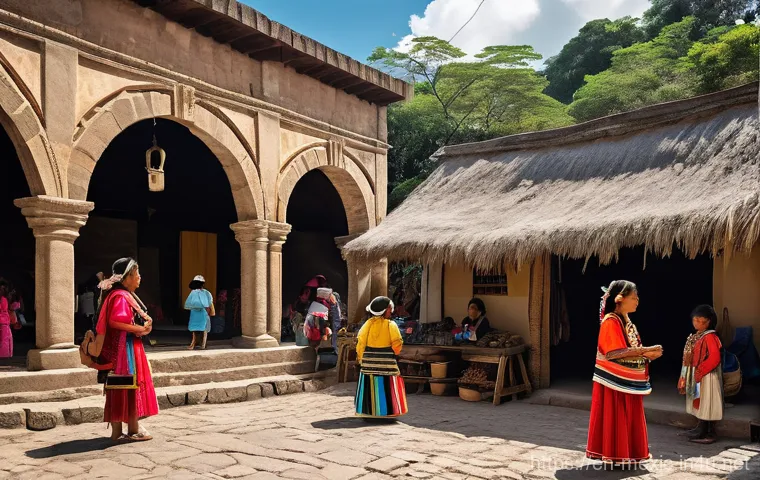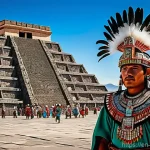Hey there, history buffs and curious minds! I’ve always been captivated by the rise and fall of great civilizations, and today we’re diving deep into one of the most dramatic stories ever told: the downfall of the mighty Aztec Empire.
For years, I believed the simplified version of the Spanish conquest, but after really digging into the details and seeing how modern historical analysis is constantly evolving (it’s wild what new perspectives emerge when you truly question the narratives!), I realized there’s so much more to unpack.
It wasn’t just a simple clash of cultures; it was a swirling vortex of political intrigue, devastating disease, and a complex web of alliances and betrayals that honestly feels like something out of a blockbuster movie.
I’ve personally found that understanding these historical nuances not only makes the past come alive but also gives us incredible insights into power dynamics and societal vulnerabilities that still resonate today.
Let’s peel back the layers and uncover the full, fascinating truth of how an empire crumbled. We’re going to explore it precisely.
It’s truly incredible how many layers there are to history, isn’t it? When I first learned about the Aztec Empire’s fall, it felt like a simple story: Spanish arrived, conquered, end of story.
But wow, after really digging in, it’s clear that narrative barely scratches the surface. What unfolded was a complex interplay of forces, both internal and external, that ultimately led to the demise of a truly remarkable civilization.
It reminds me how important it is to question the easy answers and seek out the full picture, even when it’s messy. Let’s peel back those layers together and explore how it all really went down.
The Empire’s Unsettled Foundations

You know, it’s easy to look back and see the Aztec Empire as this monolithic, all-powerful entity, but the truth is far more nuanced. Even at its peak under rulers like Moctezuma II, the empire had some deep cracks. It wasn’t a unified nation in the way we might think of European empires; it was more of a Triple Alliance that exerted hegemonic control over numerous city-states and tribes. This meant they largely maintained local leadership but demanded hefty tributes and, famously, sacrificial victims. Can you imagine the resentment simmering beneath the surface?
I’ve always found it fascinating how this system, while efficient for expansion, created a breeding ground for discontent. The conquered peoples weren’t exactly happy campers. Groups like the Tlaxcalans, for instance, were fierce rivals who had resisted Aztec domination for decades, enduring a kind of slow siege. They despised the Aztecs and those constant demands for tribute and sacrifices. This internal instability, this underlying current of animosity, was like a silent fuse waiting for a spark. It’s a powerful lesson in how even the mightiest structures can crumble from within if their foundations are built on coercion rather than genuine unity.
An Unforeseen Arrival: Cortés Lands
Imagine being in Tenochtitlan, the bustling, awe-inspiring capital, and hearing whispers of strange, pale-skinned men arriving from the sea. It must have been utterly disorienting. When Hernán Cortés and his small band of conquistadors landed on the coast in 1519, they were a world away from everything the Aztecs knew. Initially, Cortés’s expedition wasn’t even authorized, but he had a keen eye for opportunity and an unwavering ambition for gold and glory. He was truly a master of perception, knowing how to make a grand entrance while simultaneously sizing up every situation.
I often put myself in Moctezuma’s shoes during those first encounters. What do you do? Do you welcome them? Fight them? He initially tried a diplomatic approach, sending gifts and attempting to buy off Cortés, but that clearly didn’t work. This period was a fascinating dance of cultures trying to understand each other, often through interpreters like La Malinche, who played a pivotal role. The Spaniards, meanwhile, were openly forming shaky alliances with indigenous groups who were eager to escape Aztec demands, like the Totonacs and, most crucially, the Tlaxcalans. It wasn’t long before initial curiosity turned into palpable tension, and the stage was set for an epic confrontation.
The Silent Destroyer: Disease’s Devastating Blow
While the clashes of steel and obsidian make for dramatic history, perhaps the most devastating weapon brought by the Europeans was entirely invisible: disease. I mean, it’s just heartbreaking to think about. The indigenous populations had no immunity to European illnesses, and when smallpox arrived, it swept through communities like a wildfire, leaving unimaginable destruction in its wake. This wasn’t just a few people getting sick; we’re talking about epidemics that wiped out millions.
The first major wave of smallpox in 1520 was catastrophic, killing an estimated 5 to 8 million people. Tenochtitlan itself was ravaged. Imagine trying to defend your home, your family, your empire, when a significant portion of your population, including your leaders, are falling ill and dying. The emperor Cuitláhuac, who succeeded Moctezuma, actually died of smallpox. This not only caused immense suffering and population collapse but also severely crippled the Aztec chain of command and their ability to resist. It created a psychological trauma, a feeling of an unstoppable, unseen enemy that must have been utterly demoralizing. Some historians even suggest later epidemics, like the “cocoliztli” in 1545, which might have been a deadly form of salmonella, killed up to 17 million more people. It truly paints a grim picture of how microscopic invaders can have macro-level historical impacts.
Strategic Brilliance and Aztec Miscalculations
Beyond disease, the Spanish conquistadors brought distinct military advantages and employed clever strategies that the Aztecs, with their different warfare traditions, struggled to counter. It’s not just about “guns vs. clubs,” though that played a part. The Spanish had steel swords, crossbows, cannons, and horses—animals the Aztecs had never seen and initially perceived as terrifying, almost mythical creatures. I always wonder what it must have felt like to face cavalry for the first time; it had to be a shocking sight and sound.
However, what truly amplified the Spanish advantage was their ability to forge crucial alliances. Cortés, advised by interpreters like La Malinche, brilliantly exploited the existing resentments among the Aztec’s tributary states. The Tlaxcalans, in particular, became indispensable allies, providing tens of thousands of warriors, vital intelligence on local geography, and logistical support. It wasn’t just a small Spanish force conquering a vast empire; it was a Spanish-led coalition of indigenous allies against the Aztec Triple Alliance. The Spanish also adapted their tactics, learning to fight in the Mesoamerican terrain. The Aztecs, on the other hand, had a highly ritualized style of warfare, often focused on capturing prisoners for sacrifice rather than outright killing, which put them at a disadvantage against the Spanish intent on total conquest. This table sums up some of those key differences:
| Factor | Aztec Warfare | Spanish Warfare |
|---|---|---|
| Primary Goal | Capture for sacrifice, tribute collection | Territorial conquest, wealth, religious conversion |
| Weaponry | Obsidian-bladed clubs (macuahuitl), bows, spears, atlatl | Steel swords, lances, crossbows, arquebuses (firearms), cannons |
| Armor | Quilted cotton armor, wooden shields | Metal armor (helmets, breastplates), steel shields |
| Transportation/Animals | Foot soldiers, no beasts of burden in warfare | Horses (cavalry), war dogs |
| Tactics | Ritualized combat, formation fighting, numerical superiority | Aggressive, shock tactics, combined arms, siege warfare |
Moctezuma’s Impossible Burden
Leadership, especially under extreme duress, can make or break an empire, and Moctezuma II’s reign was certainly put to the ultimate test. He was a powerful ruler, at the height of his influence when Cortés arrived, but he faced an entirely unprecedented challenge. His initial approach to the Spanish has often been depicted as hesitant or even cowardly, driven by prophecies of returning gods. However, modern historical analysis often challenges this simplified view, suggesting Moctezuma was likely navigating a complex political landscape, using diplomatic maneuvers typical of Mesoamerican interstate relations, even if they appear baffling to us now.
He allowed Cortés and his men into Tenochtitlan, even housing them in his palace. It’s hard to truly fathom his mindset—perhaps he believed he could control them, or that they were a curiosity to be contained. But this decision ultimately backfired. Cortés eventually took Moctezuma captive, effectively making him a puppet ruler within his own city. This act, more than any other, eroded the respect of his people and undermined his authority irrevocably. When he tried to quell an Aztec uprising sparked by a Spanish massacre during a religious festival, he was reportedly struck by stones and arrows from his own people. His death, whether by Spanish hand or his own people’s, marked a tragic turning point, leaving the empire without its primary leader in its most desperate hour.
The Night of Sorrows and a Resilient Pushback

You can almost feel the tension building to a breaking point, can’t you? After Moctezuma’s death and a massacre of Aztec nobles by the Spanish under Pedro de Alvarado, the people of Tenochtitlan had had enough. They rose up in a fierce revolt, driving the Spanish and their Tlaxcalan allies out of the city in a chaotic, bloody retreat known as “La Noche Triste,” or “The Night of Sorrows.” This was no easy victory for the conquistadors; it was a brutal defeat where they lost a significant portion of their men, equipment, and the gold they had plundered. Many Spaniards drowned in the canals, weighed down by their armor and loot. It truly shows how formidable the Aztecs were when unified and fighting on their home turf. I mean, after that night, Cortés apparently wept under a tree, a symbol of just how utterly defeated he felt.
But here’s where the narrative shifts again: the Spanish, though badly bruised, didn’t give up. They retreated to Tlaxcala, where their indigenous allies helped them recover, resupply, and, incredibly, regroup. The new Aztec emperor, Cuitláhuac, tried to rally other indigenous groups against the Spanish, but the Tlaxcalans, still deeply resentful of Aztec rule, refused to join him. This period of regrouping was crucial, allowing Cortés to reinforce his forces and build brigantines—small warships—that would prove essential in the final siege of Tenochtitlan. The resilience of the Aztecs after Noche Triste was undeniable, but the Spanish, with their tactical adaptability and staunch allies, were preparing for the final, decisive assault.
The Final Siege and a Transformed Legacy
The stage for the ultimate confrontation was set. In May 1521, Cortés, with a massive coalition army composed of his greatly augmented Spanish forces and tens of thousands of indigenous allies, laid siege to Tenochtitlan. It was an epic, drawn-out struggle lasting 93 days, a brutal and relentless assault on a city already weakened by disease and famine. The Spanish used their brigantines to control the lake and block the causeways, effectively cutting off supplies and reinforcements to the island city. I can only imagine the sheer desperation and heroism on both sides during those months.
The Aztecs, under their final emperor Cuauhtémoc, fought valiantly, but they were ultimately overwhelmed. On August 13, 1521, Tenochtitlan fell. The city, once a marvel of engineering and culture, was largely destroyed in the process. This event marked the end of the mighty Aztec Empire and the beginning of Spanish colonial rule, leading to the establishment of New Spain. While the conquest was devastating for the Aztec people, it also led to a complex cultural fusion. Aspects of Aztec language (Nahuatl), art, agriculture, and cuisine endured, influencing the developing Mexican culture. It’s a powerful, sobering reminder of how history reshapes everything, leaving a legacy that’s both tragic and enduring, continuing to influence modern Mexico in profound ways.
Wrapping Things Up
And so, we’ve journeyed through the intricate, often heartbreaking, story of the Aztec Empire’s collapse. It’s a tale that challenges simple explanations, isn’t it? What began as whispers of strange ships on the horizon spiraled into a confluence of factors – internal discord, devastating disease, clashing military strategies, and profound cultural misunderstandings – all culminating in the fall of one of history’s most magnificent civilizations. Reflecting on it, I’m always struck by how fragile even the most powerful empires can be when faced with truly unprecedented challenges. It really makes you think about the ripple effects of every decision and the profound impact of unseen forces like pathogens.
It’s a powerful reminder that history is rarely black and white, but rather a vibrant, complex tapestry woven with countless threads of human experience, ambition, tragedy, and resilience. Understanding this period isn’t just about dates and names; it’s about appreciating the incredible human stories and the enduring legacy that continues to shape Mexico today. If you ever get the chance to visit Mexico City, you’ll feel the echoes of Tenochtitlan beneath your feet, a truly humbling experience that brings these ancient narratives to life in a way no book ever could.
Useful Information You Might Like
1. Explore the Templo Mayor Museum in Mexico City: If you’re ever in Mexico, this museum, built directly on the ruins of the Aztec’s main temple, offers an incredible, immersive experience. Walking through it, you can almost hear the echoes of ancient Tenochtitlan, giving you a tangible connection to the empire we’ve just discussed and a real sense of its former grandeur. It’s truly a must-see for history buffs.
2. Dive into Primary Sources (in translation, of course!): Accounts from both Spanish conquistadors (like Cortés’s letters) and indigenous chroniclers offer fascinating, if sometimes biased, perspectives. Reading them yourself really opens up a new window into their world and helps you form your own conclusions, rather than relying solely on modern interpretations. You’d be surprised how vivid these firsthand accounts are.
3. Understand the Lingering Influence of Nahuatl: Even today, many words in Mexican Spanish and even some English words have Nahuatl origins (think ‘chocolate,’ ‘tomato,’ ‘avocado,’ and ‘chili’). It’s a cool testament to how cultures blend and leave their mark, even after monumental shifts, reminding us that no culture ever truly vanishes without a trace. It’s a fun linguistic treasure hunt once you start noticing them!
4. Consider the Broader Impact of the Columbian Exchange: The fall of the Aztec Empire is a key part of this global phenomenon. Beyond diseases, the exchange of plants, animals, and cultures fundamentally reshaped both the Americas and Europe in ways that are still evident today. It truly was a moment of global transformation, demonstrating how interconnected our world became centuries ago, for better or worse.
5. Look Beyond the Conquest Narrative: While the conquest is significant, remember that Mesoamerican history is incredibly rich and spans thousands of years before Cortés. Exploring the Olmecs, Mayans, Teotihuacanos, and Zapotecs will give you an an even deeper appreciation for the region’s incredible past and pre-Columbian achievements. There’s a whole universe of ancient civilizations waiting to be discovered beyond just the Aztecs!
Key Takeaways
The fall of the Aztec Empire was a truly multifaceted event, far from a simple act of conquest by a small Spanish force. It was heavily influenced by the pre-existing internal divisions within the empire, with numerous subjugated states eagerly allying with Cortés to throw off generations of Aztec rule. The devastating impact of European diseases, particularly smallpox, which ravaged the indigenous population and leadership, created an insurmountable biological advantage for the invaders, crippling their ability to fight back. Furthermore, the Spanish brought superior military technology and highly adaptable combat strategies, while skillfully exploiting cultural differences and political weaknesses among the various indigenous groups. Lastly, the initial leadership decisions of Moctezuma II, followed by a fierce but ultimately overwhelmed resistance from Cuauhtémoc, played critical roles in determining the empire’s fate. It’s a truly complex story of intertwined factors, a powerful historical lesson in how internal cracks, external pressures, and unforeseen circumstances can bring down even the most formidable powers.
Frequently Asked Questions (FAQ) 📖
Q: Was the fall of the
A: ztec Empire solely due to the Spanish conquistadors’ military superiority? A1: Oh, if only history were that simple, right? For the longest time, I thought it was just Cortés and his handful of Spanish soldiers waltzing in and easily conquering everything with their steel and gunpowder.
But after really looking into it, that’s a massive oversimplification that really does a disservice to the complex reality. While the Spanish definitely had technological advantages like steel weapons, firearms, and horses that were completely new to the Aztecs, their small numbers meant they absolutely could not have toppled an empire of millions on their own.
The truth, which I found truly eye-opening, is that the Spanish success was overwhelmingly dependent on forming strategic alliances with indigenous groups who were already enemies or resentful subjects of the Aztecs.
Groups like the Tlaxcalans, for instance, were long-standing rivals and were instrumental, providing tens of thousands of warriors to fight alongside Cortés.
Imagine that: a massive coalition, mostly indigenous, fighting against the Aztec Triple Alliance. It makes you rethink the whole narrative, doesn’t it?
It wasn’t just a Spanish conquest; it was a complex civil war with the Spanish as a catalyst, exploiting deep-seated political tensions within Mesoamerica.
Q: How significant a role did European diseases play in the
A: ztec Empire’s collapse? A2: This is a heartbreaking, yet absolutely crucial, part of the story that often gets less attention than the battles themselves, but for me, it really drives home the sheer devastation.
European diseases, particularly smallpox, were probably the deadliest weapon the Spanish inadvertently brought with them. The indigenous populations had zero immunity to these foreign illnesses, which had ravaged Europe for centuries.
When smallpox arrived in Mesoamerica, it spread like wildfire, decimating communities and wiping out an estimated one-third to one-half of the population in Tenochtitlán alone.
Can you even imagine that level of loss? I’ve read accounts that describe how entire families were too sick to care for each other, literally starving to death in their beds because no one was well enough to fetch food or water.
It crippled the Aztec’s ability to resist, killing leaders, warriors, and civilians alike, shattering their social structures, and causing immense psychological trauma.
While the Spanish were recovering and regrouping after being initially pushed out of Tenochtitlán during the “La Noche Triste,” smallpox was quietly but brutally tearing through the Aztec capital.
When Cortés returned for the final siege, he found a city already weakened, its people demoralized and its leadership severely diminished. It’s a stark reminder of how unseen forces can shape history in the most profound and tragic ways.
Q: Did the
A: ztecs make any critical mistakes that contributed to their own downfall? A3: Absolutely, and this is where it gets really fascinating because it shows how even mighty empires can be vulnerable from within.
From what I’ve gathered, the Aztec Empire, despite its grandeur, had an inherently unstable system of governance. It wasn’t a unified nation but more of a hegemonic empire, essentially a triple alliance that demanded heavy tribute, including human sacrifices, from its conquered city-states.
This created deep resentment and made many subject peoples eager to break free from Aztec rule. When Cortés arrived, he was incredibly shrewd in identifying and exploiting these existing animosities, quickly forming alliances with these disgruntled groups, most notably the Tlaxcalans.
So, one major “mistake,” if you can call it that, was the very structure of their empire, which bred internal enemies that the Spanish expertly turned into allies.
Another factor often debated is Montezuma II’s initial response to Cortés. While the myth of him believing Cortés was a returning god, Quetzalcoatl, has largely been debunked by modern historians (thank goodness we’re moving past those Eurocentric fabrications!), his decision to welcome the Spanish into Tenochtitlán was certainly a tactical misstep.
He likely saw them as another powerful group to be managed, perhaps even integrated into the existing political landscape, underestimating their ruthlessness and ultimate goals.
This allowed the Spanish to gain crucial intelligence, take Montezuma hostage, and destabilize the capital from within. It’s easy to judge with hindsight, but in the whirlwind of those first encounters, even a seasoned ruler like Montezuma made choices that, combined with all the other factors, unfortunately paved the way for the empire’s tragic end.
It really drives home that history is rarely about one single cause, but a perfect storm of circumstances, decisions, and devastating external forces.






